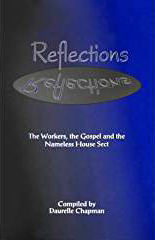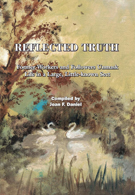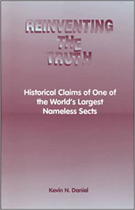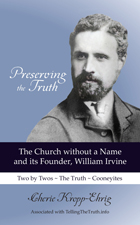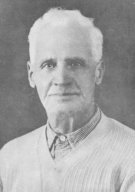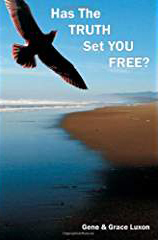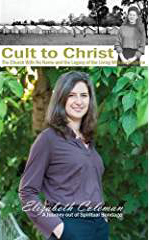Division of 1928
Edward Cooney Cast Out -- Division, Purge and Exodus
The Workers Regroup. Since Irvine was no longer their authority, what should remain the same? What should be changed or jettisoned? How should their group continue? Irvine's power had been removed, but his teachings lived on. Some, but not all, of the Workers remained certain their sect was God's Only True Way and accepted the Senior Workers' decision to excommunicate Irvine as righteous.
Cooney had mixed feelings. He brooded and grieved through the years as he saw their ideal ministry and church go downhill to something he could not countenance. Through the years, the Two by Two Sect had adopted various beliefs and practices with which he disagreed, and it saddened him. He did not, however, believe the whole mission was a mistake; he continued to believe Irvine's original idea to follow Matthew 10 was a revelation.
After William Irvine was no longer their leader, Cooney mounted a campaign for the Workers to return to their original design, the way they were in the first four years he and Irvine preached together. Cooney stressed: "Undoubtedly God called us and separated us to be his people at the beginning, and most prominent and most used in this calling out a people for God's name was William Irvine, who, at the time of his being sent forth to be a prophet saw more clearly than any of us the revelation of the Father to each individual child of His is the Rock alone on which Jesus Christ alone would build His Church...Our only hope is to get back to the simplicity and childlikeness of the beginning, especially those of us who have the oversight" (to My Dear Sister, May 1930).
Cooney believed organization of religion was unscriptural. He longed to go back to the freedom the Workers enjoyed in the Sect's early days when they were controlled solely by the Holy Spirit. Like Irvine, Cooney, as Second-in-Command, claimed no particular field and recognized no boundaries; the two roved the world wherever they felt led to do so. The Workers wanted Cooney to restrict his movements and obtain permission before preaching in the fields of other Workers.
Cooney struggled to persuade the Senior Workers to discard the hierarchy and organization that divided the movement among geographical fields and the membership into classes of Overseers, Workers, and Friends. He felt the Workers should all be servants--not rulers over other Workers or the Saints . He endeavored to show the Senior Workers how they were setting themselves up over the Friends similar to the way Irvine had been set up over the Workers.
Cooney firmly believed the Workers should have freedom to express whatever God revealed to them. To do otherwise, Cooney thought, was controlling the Holy Spirit. He explained, "At the beginning we were all free to express the revelation God made clear to our hearts" (To My Dear Sister, 1930). "William Irvine and I were drawn together as brothers in Christ, each of us claiming liberty to follow Jesus as we received progressive light from God by the Spirit" (To Alice Flett, circa 1930).
On the other hand, the Workers did not want Cooney expressing any "revelation" he had in their fields--unless they agreed with it. Wilson Reid remarked, "Eddie...had begun teaching things on his own without consulting any of the brothers" (to Brothers and Sisters in Christ, Dec. 13, 1928 , TTT ) . Cooney exasperated the Workers for they never knew what might come out of his mouth, and they had to deal with the fallout left in his wake in their fields. His free words and freedom of movement upset their accepted organizational order.
In Cooney's opinion, the Living Witness Doctrine was a heresy that had crept in and permeated the Sect; that Friends and Workers had lost their liberty in Christ through it. Cooney believed that God had children everywhere and that the Doctrine should be jettisoned. He viewed Irvine's downfall as a sign that God wanted the Workers to revoke and renounce it. He urged, "Let's return to the Lord, and He will return unto us." The timing seemed perfect for the Senior Workers to renounce and repent of the Living Witness Doctrine and go back to the way Cooney and Irvine had preached for the four years (1901-05) before the Living Witness Doctrine's introduction.
The downside of Cooney's proposal was that removing the Living Witness Doctrine would seriously compromise the Workers' most valuable marketing tools in persuading outsiders to join their sect. It also ensured member retention. No longer unique, their Sect would be just another church started by a man. In turn, this would mean people could be saved outside of it it--that it was not God's Only True Way. The Workers refused to surrender the Living Witness Doctrine, choosing instead to retain the status quo. It has continued to be an integral part of their doctrine since 1905-07.
Cooney also:
• Disapproved of the Workers assuming the name, The Testimony of Jesus , in Great Britain during World War I. It was not just taking a name that troubled him--it was also the name itself. Cooney saw that while they could give the testimony of Jesus--they could not be the testimony of Jesus.
• Disapproved of the movable halls used for missions and living quarters; they showed a lack of faith. He believed Workers should stay overnight in homes, not in beds in wooden huts. He told the other Workers: "I'll have fellowship with you if you use them, but don't ask me to use them."
• Disapproved of annual conventions. He did not believe there was any scriptural basis for holding conventions. Critical of the vast amount of time, organization, and coordination required to prepare and hold the conventions, he also objected to Workers going on prearranged convention tours, instead of going wherever the Spirit led them to save souls.
1914: Cooney's Renunciation. Cooney made a wholehearted, valiant effort to turn the leading Workers away from the errors that he saw had infiltrated the sect over the years--without success. Therefore, in 1914, he gave up, and openly renounced the Living Witness Doctrine for himself, declaring, "I had returned to the true gospel William Irvine and I with others preached for some four years before these heresies were introduced " (to Alice Flett, circa 1930). In retrospect, the Workers would pinpoint the chief issue that proved Cooney was "out of step with his brethren" was his renunciation of the Living Witness Doctrine.
While Cooney believed all religious systems, institutions, and organizations were unscriptural, he still believed there were people in them who were born-again (Patricia Roberts 1990, 125). This was radically different from the Living Witness Doctrine the Workers still believed and taught: "A person can be born-again by a living witness--without one never."
Cooney also reclaimed his original conversion to Christ that took place in his heart in 1884 by his bedside at age seventeen--long before he met William Irvine. At the time, Wilson Reid was the Overseer of Ireland, Cooney's native home and base. "As regards the cause of the trouble, it is not a thing of today or yesterday but a matter of years," Reid recollected. "The first I clearly saw of it was in 1916, although others can trace it back much further. About this time Eddie began to change his testimony and went back to claim he was saved at seventeen years old, which was many years before he began walking in The Truth " (to Brothers and Sisters, December 13, 1928 , TTT ).
He also repossessed the belief they held in the early days that people could come to Christ through various means; e.g., nature, scriptures, revelation, individuals, preachers, etc. and that there were people saved outside their group. This meant that he no longer considered the Two by Two Sect to be God's Only True Way. Instead, he believed and preached that "God has his children everywhere, even among the heathen."
1914-1921. Cooney refused to be muzzled and continued preaching wherever he felt led to do so in Great Britain and Ireland. For seven years, the gulf between Cooney and the Senior Workers widened as he disregarded their generally accepted order. Meanwhile, most Friends were unaware of the conflict.
1921-1928: Cooney Went Abroad. The leading Workers urged Cooney to travel abroad, hoping that by mingling with other Overseers, he might fall in line, give up his liberty, and be willing to submit to their order and control. On August 4, 1921, Cooney, age fifty-four, boarded the SS Empress of France in Liverpool, England, headed for Quebec, Canada, along with Willie Gill, George Walker, and Jack Carroll. For the seven years between 1921 and 1928, Cooney traveled in the U.S., Canada, New Zealand, and Australia. The Workers plan did not have its desired effect on Cooney.
Banned in New Zealand. In 1921, Cooney spoke in the New Zealand special meetings, and soon managed to antagonize the New Zealand Workers to the point they banned him from their meetings. Reportedly, the final straw was when Cooney attempted and failed to heal a young woman.
Ed Cooney's brother, Fred, had immigrated with his family to New Zealand in 1924. He wrote Wilson McClung, "You waited until he had sailed from New Zealand before you set the ball rolling. Furthermore, you forbade fellowship with those who declared belief in Eddie as a Servant of God; so brother denied brother and Satan smiled as Isaiah 9:20-21 was being fulfilled among us...As regards the doctrine that only through the lips of a true preacher can salvation come to a human soul, I do not believe it; and I refuse to add conditions not found in God's Word" (June 1, 1930 , TTT). Fred left the Sect. Those who were loyal to Cooney began holding their own separate meetings.
Australia . Cooney left New Zealand for Australia, where he stayed until early 1925. Bill Carroll, Overseer of Victoria, concluded that Cooney's problem was, "We preach not ourselves. We do not wish to exalt ourselves or our own name. That was the lamentable and dreadful sin of Edward Cooney. We had to come to the definite belief after many years of patience that he preached himself. His message was to exalt his own name, which has been put upon God's people and which God's people reject and resent " ( Dec. 16, 1950 , Sermon, TTT ).
Wilson Reid asserted that Cooney " got worse, until in 1925 some of the brothers in Australia and New Zealand sent home quite a few letters showing that the trouble with Eddie had become very serious" (to Brothers and Sisters, Dec. 13, 1928, TTT ).
After disturbing the Australian Workers for four years, Cooney (age fifty-eight) left Sydney on April 3, 1925, aboard the SS Aorangi for Vancouver, Canada, headed for the U.S.
Banned by Jack Carroll in Western U.S. and Canada. Jack Carroll, Overseer of the Western U.S. Alliance, asked Cooney not to preach in areas where Jack had previously ministered. Believing God had led him to Seattle, Cooney ignored Jack's request and held a mission there; one man professed. Jack instructed the Friends to boycott Cooney's mission, and to withhold their support and shelter. For three years, Cooney was forced to work in his former trade, the clothing business (Patricia Roberts 1990, 140).
George Walker, James Jardine, and some other Workers went to Seattle hoping to settle the rift between Jack Carroll and Ed Cooney and to make it possible for Cooney to remain in fellowship. Cooney considered their "suggestive proposal," but rejected it, as it required him to leave Seattle, where he felt God had led him.
Banned by George Walker i n Eastern U.S. Three years later in 1928, George Walker, Overseer of the Eastern U.S. Alliance, told Cooney in Edgar Hawkins' home in Detroit, Michigan, that he was not welcome in his territory. Nor was Cooney welcome in James Jardine's territory, who had the oversight of the North Central States of Wisconsin, Minnesota, and North Dakota.
Blacklisted in Ireland. Before Cooney arrived back in the British Isles, the Workers had begun warning the Irish Friends that there was "trouble with Cooney"; that Cooney had changed, something had gone wrong with him, and he was out of step with the other Workers. He was portrayed as not being born again, a deceiver, a preacher of false doctrine, a false shepherd guilty of committing "awful crimes."
Being a native of Northern Ireland, Cooney had many 2x2 converts there. Two of his staunchest supporters were brothers, John and William West and their families, from Ballinamallard, both of whom hosted conventions on their properties. John West and Cooney were longtime close friends who had enjoyed Bible studies together in Enniskillen long before William Irvine came along.
Wilson Reid, who often visited the home of John and Sara West, informed them Cooney was returning from America where he had been causing trouble and warned them not to have fellowship with him. Sara West wrote: "My husband and others suggested having a meeting on Bible lines with elders and have Edward Cooney there too, so that both sides would be heard by them to judge. A meeting was arranged in Irvinestown--but Edward Cooney was not there" (Sara West 1954, TTT ).
The Workers arranged for a meeting of Workers and Friends at James Bothwell's home in Irvinestown to discuss the Cooney situation--without Cooney being present. After the meeting, Bothwell wrote Wilson Reid: "I did everything I could to have all present, thinking there might be something wrong with Eddie. But when all was told, I found nothing to condemn Eddie for, no evidence, but only untrue reports written and carried across the country by false and jealous brethren...I think [it] was unkind to come round behind Eddie's back and pour in all that poison and him not here to defend himself" ( Dec. 28, 1928, TTT ).
Bothwell, the Wests, and some others decided to keep an open mind until they heard Cooney's side. Bothwell wrote Wilson Reid, "I also opened my home to Eddie for him to explain the awful 'crimes' he was being accused of by you and George Walker. If the 'crimes' were so terrible, why did you state here that if Eddie would consent and fall in line with all the others, you would all be one in the morning ?" ( Dec. 28, 1928 , TTT ).
"We thought it very strange," explained Sara West, "to hear that Edward would change and preach false doctrine inside a few years because we knew that God had used him in a great measure in different parts of England and Ireland. Wilson Reid and many in fellowship with us never came back to our home after making the decision to hear Edward Cooney's side...When Edward Cooney did come back, we could not see any change in him; he was as sincere and ardent as ever, preaching the same simple gospel as we heard at the beginning" (Sara West 1954, TTT ).
William West reminded George Walker: "You said when you were here that it would be no harm for anybody who felt so inclined to go and hear Eddie; and above all you said there could be no separation, excommunication or division in the family of God...Fortified by this assurance, I like many others went to hear Eddie" (to George Walker, Oct. 1929 , TTT ).
Instead of things happening like Walker told West, two Workers (Sam McClements and Hugh Breen) went around directing those who met in the West's home for fellowship meetings not to come any more; half the church turned against them. He and his wife were judged and treated as if they were enemies of God. Incredibly, they suddenly found themselves the victims of bitter hatred and prejudice from the very ones with whom they had worshipped for twenty-five years.
1928, October 12: Senior Worker Meeting. Ed Cooney arrived in Belfast, Ireland, on Saturday, October 6, 1928, from Montreal, Canada, aboard the SS Andania . Plans had been made secretly to give Cooney a last-chance ultimatum. Several Senior Workers from around the world were en route, if not already in Ireland, to attend this assembly.
A week after Ed Cooney arrived, a dozen Senior Workers squared off against him in the home of Andrew Knox in Clankilvoragh, Lurgan, Ireland. They were Jack Carroll, William Weir, Willie Gill, Wilson Reid, James Jardine, Joe Twamley, Andrew Robb, Nat Dickson, Robert Miller, Ben Boles, and Tom Elliott. Jack Carroll appeared to be the Worker in charge of the meeting. No representatives from Australia or New Zealand were present; nor was George Walker.
The purpose of the meeting was a final attempt to get Cooney to agree to restrict his ministry. The conditions necessary for the basis for fellowship had been hammered out earlier in a Solemn Agreement they presented to him :
"(1) That no Worker would teach or preach anything contrary to what the Worker in whose field he was labouring believed without his permission.
"(2) That if a Worker desired to preach anything which the Workers as a whole did not agree with, he was to go to a part where the Workers had never been in order to do so" (Lurgan Meeting 1928).
Cooney refused to agree to the conditions laid out, declaring he would retain the liberty God gave him when he first started preaching. He wrote: "If I had agreed to abide by these decrees, I would henceforth have been subject to rules which we in public denied existed in this fellowship " (Patricia Roberts 1990, 143 ).
When the impasse appeared insurmountable, Jack Carroll declared he would have no more fellowship with Edward Cooney and left the room. The remaining ten Workers followed suit, with the exception of Thomas Elliott, who was also cast out of the Sect. In their early days, Tom had conducted most of the baptisms of new converts, earning him the nickname of "Tom the Baptist." Ironically, it was Tom who had baptized the Workers who excommunicated Edward and Tom. Afterwards, Cooney posed the question: "The baptism of Tom--was it of man or of God?"
Some of Cooney's narrative of the Lurgan meeting reads:
" This is a true description of what took place on that memorable occasion; and as the untruth has been spread that I went out of fellowship from my brethren and thereby caused a division, I write to let you know that I earnestly desired, and still earnestly desire, to remain in the fellowship of my brethren on the same condition as we had from the beginning, viz., that 'the truth as it is in Jesus' be the only test by which His disciples are to be disciplined, and that the Scriptures are to be the only written revelation accepted as declaring the truth.
" It seems to be unknown by many of God's children and unrealized by most that on October 12th, 1928 , at Clankilvoragh, Lurgan, Ireland, at a meeting of those who might be called the apostles amongst the people of God--indeed there happened to be twelve present--a verbal Agreement was submitted by the summer-up, James Jardine, expressed by John Carroll, called by the latter different times a 'Solemn Agreement' binding all the Workers not to express individual revelation even though true if the Worker in whose field they were had not yet seen it. This verbal Agreement was, as declared at that historic meeting and apostolic council, a 'Basis of Fellowship for all Workers. '" (Lurgan Meeting 1928)
Cooney was sixty-one years of old when he was excommunicated and had been preaching in the Sect for twenty-seven years.

 REPRESENTING THE LARGEST COLLECTION OF 2X2 HISTORICAL DOCUMENTS ON THE INTERNET
REPRESENTING THE LARGEST COLLECTION OF 2X2 HISTORICAL DOCUMENTS ON THE INTERNET
 Perry, Oklahoma Conv, 1942
Perry, Oklahoma Conv, 1942
